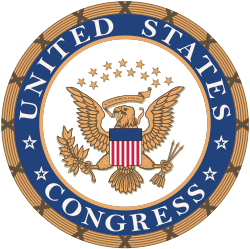3. Kongress der Vereinigten Staaten
| ‹ 2 • | |
| 3. Kongress der Vereinigten Staaten | |
| 4. März 1793 – 4. März 1795 | |
| Präsident | George Washington (U) |
| Mitglieder | 30 Senatoren 105 Abgeordnete |
| Senatsmehrheit | Pro-Administration (P) |
| Senatspräsident | John Adams (P) |
| Hausmehrheit | Anti-Administration (A) |
| Speaker | Frederick Muhlenberg (A) |
Senat Insgesamt 30 Sitze
Repräsentantenhaus Insgesamt 105 Sitze
| |
Der 3. Kongress der Vereinigten Staaten tagte zwischen dem 4. März 1793 und dem 3. März 1795, dem fünften und sechsten Amtsjahr von Präsident George Washington. Er trat in der Congress Hall in Philadelphia zusammen. Im Senat gab es eine Mehrheit für die Washington-unterstützende Pro-Administration Party, im Repräsentantenhaus eine Mehrheit für die opponierende Anti-Administration Party.
Bedeutende Ereignisse
- 22. April 1793: George Washington unterzeichnet die Neutralitätsproklamation, wonach sich die Vereinigten Staaten in den Koalitionskriegen neutral verhalten würden.
- 14. März 1794: Eli Whitney erhält ein Patent für die Egreniermaschine.
- 27. März 1794: Der Kongress autorisiert den Bau der ersten sechs Fregatten der United States Navy.
- 7. August 1794: Aufgrund des Whiskey Act, einer Verbrauchsteuer auf Whiskey, kommt es zur Whiskey-Rebellion, einem Aufstand von Siedlern in Pennsylvania, der von der Bundesregierung mit militärischer Hilfe niedergeschlagen wird.
- 20. August 1794: Die Schlacht von Fallen Timbers geht mit einer Niederlage für die indianischen Stämme aus.
Bedeutende Gesetzgebung
- 4. März 1794: Der Kongress verabschiedet den 11. Zusatzartikel zur Verfassung der Vereinigten Staaten, womit Bundesstaaten vor Gerichtsverfahren nach Bundesrecht geschützt werden sollen. Der Zusatzartikel wird am 7. Februar 1795 von 12. Bundesstaat ratifiziert und tritt damit in Kraft.
- 27. März 1794: Mit dem Naval Act of 1794 errichten die Vereinigten Staaten ihre erste Marine.
- 19. November 1794: Die Vereinigten Staaten gehen mit dem Königreich Großbritannien den Jay-Vertrag ein, der noch offene Spannungen und Streitfragen aus dem Amerikanischen Unabhängigkeitskrieg klären soll.
- 29. Januar 1795: Der Naturalization Act of 1795 transformierte den Einbürgerungsprozess in ein zweistufiges Verfahren und verlängerte den Mindestaufenthalt in den Vereinigten Staaten auf fünf Jahre, bevor die Einbürgerung vorgenommen werden kann.
Parteien
Weder im Senat noch im Repräsentantenhaus gab es zu diesem Zeitpunkt organisierte Parteien. Es gab jedoch zwei Gruppierungen, die Anti-Administration Party und die Pro-Administration Party. Während Mitglieder der Anti-Administration Party später die Demokratisch-Republikanische Partei begründeten, war die Pro-Administration Party die Vorläuferpartei der Föderalistischen Partei.
Repräsentantenhaus
| Gruppierung | Anfang | Ende | |||
|---|---|---|---|---|---|
| Abgeordnete | Stimmenanteil | Abgeordnete | Stimmenanteil | ||
| Pro-Administration (P) | 50 | 47,6 % | 49 | 47,6 % | |
| Anti-Administration (A) | 55 | 52,4 % | 54 | 52,4 % | |
| Vakant | 0 | 2 | |||
| Summe | 105 | 103 | |||
Senat
| Gruppierung | Anfang | Ende | |||
|---|---|---|---|---|---|
| Senatoren | Stimmenanteil | Senatoren | Stimmenanteil | ||
| Pro-Administration | 16 | 55,2 % | 17 | 56,7 % | |
| Anti-Administration | 13 | 44,8 % | 13 | 43,3 % | |
| Vakant | 1 | 0 | |||
| Summe | 29 | 30 | |||
Führung
Mitglieder
Repräsentantenhaus
Senat
Connecticut
Delaware
Georgia
Kentucky
Maryland
Massachusetts
New Hampshire
New Jersey
| New York
North Carolina
Pennsylvania
Rhode Island
South Carolina
Vermont
Virginia
|
Personelle Veränderungen
Im Repräsentantenhaus kam es zu zwei Todesfällen, drei Rücktritten sowie einer angefochtenen Wahl. Im Senat kam es zu einem Todesfall, drei Rücktritten sowie einer angefochtenen Wahl.
Angestellte
Repräsentantenhaus
- Clerk: John Beckley
- Sergeant at Arms: Joseph Wheaton
- Pförtner: Gifford Dalley
- Geistlicher: Ashbel Green
Senat
- Sekretär: Samuel A. Otis
- Sergeant at Arms: James Mathers
- Geistlicher: William White
Weblinks
Auf dieser Seite verwendete Medien
Copy of Joseph Wright's 1790 portrait of Frederick A. C. Muhlenberg. Muhlenberg served as the first Speaker of the U.S. House Representatives.
Waugh painted this copy 80 years after Muhlenberg's death. Note that Waugh changed background and the color of the chair's upholstery.
Henry Tazewell
Ralph Izard (U.S. Senator)
Naval Historical Center, Washington, D.C. -- A painting of President John Adams (1735-1826), 2nd president of the United States, by Asher B. Durand (1767-1845). Every October 30th, the birthday of John Adams, Naval Reserve Center (NRC) Quincy, Mass., conducts a wreath-laying ceremony at First Parish Church. Both Adams and his son President John Quincy Adams are buried at the church. Adams was one of the leading advocates for the creation of a Continental Navy, he drafted the first set of rules and regulations for the new navy. He was able to convince the Congress to pass an “Act Providing a Naval Armament,” which was less than he thought was necessary but at least provided for the equipping of three frigates, the Constitution, the United States, and the Constellation. U.S. Navy photo. (RELEASED)













